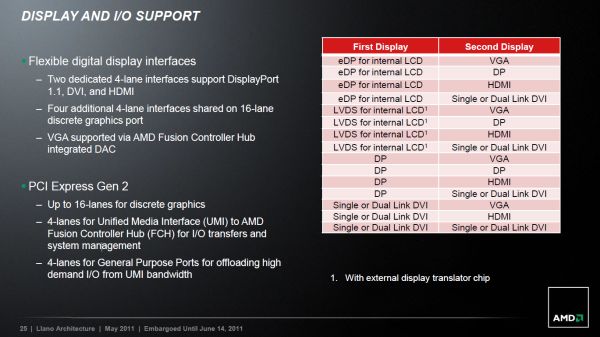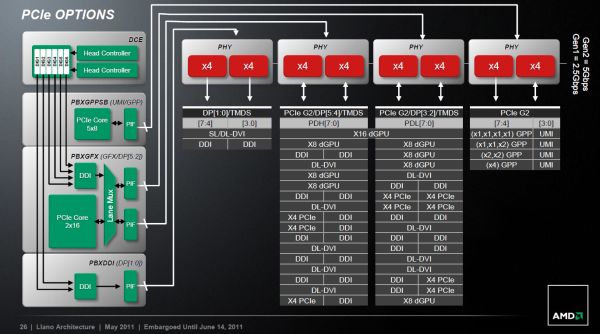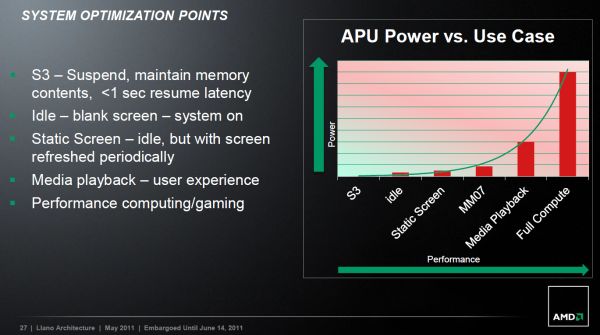Desktop Llano Motherboards: The ASRock A75 Extreme6 Preview
by Ian Cutress on June 14, 2011 12:00 AM EST- Posted in
- Motherboards
- ASRock
- Llano
It's been a while since we've discussed AMD motherboards at AnandTech—over the next few months, I am hoping to bring them back. To start, we have our first Desktop Llano product on the test bed—the ASRock A75 Extreme6. Unfortunately, what I've been testing is still 'a work in progress'—so there are issues with the BIOS and design still to be decided. For now I'll let you know what I've found, in terms of performance and design. But when the full board comes my way with release information, I'll post a full review.
The desktop Llano series is the mainstream jewel in the AMD calendar. As Anand has discussed, the Fusion APU architecture of AMDs plan is split between the Brazos platform (with Ontario and Zacate) of sub 18W processors with Bobcat cores, and the Lynx platform (with Llano) for 25-100W processors. The former has 1-2 Bobcat cores, whereas with Llano we're dealing with 2-4 K10 cores.
In terms of motherboard design, the Llano processors absorb any form of Northbridge, and the motherboard will use a series of 'Fusion Controller Hubs', codename Hudson. The desktop version will use the Hudson-D series Fusion Controller Hubs, with the A75 Desktop 'Lynx' models under the Hudson-D3 header. The main selling points will be the six native SATA 6 Gbps ports and the four native USB 3.0 ports.
The Lynx platform comes up with some interesting points: hybrid CrossfireX with any 6-series GPU and the APU, native USB 3.0 and SATA 6 Gbps, and dual channel DDR3-1866 native support. Here's some comparisons with P67:
| Hudson-D3 | P67 | |
|---|---|---|
| Codename | Lynx (Desktop) | Sandy Bridge |
| SATA 6 Gbps + 3 Gbps | 6 + 0 | 2 + 4 |
| Memory Support | DDR3-1866 | DDR3-1333 / 2133 OC |
| PCIe | 16x or 8x/8x | 16x or 8x/8x |
| RAID | 0,1,10 | 0,1,5,10 |
| USB 3.0 + 2.0 + 1.1 | 4 + 10 + 2 | 0 + 14 + 0 |
| Display Output |
VGA + 1 dedicated / 4 shared (HDMI/DVI/DP) from APU |
VGA + 3 HDMI/DVI/DP |
| FIS-Based Switching | No | Yes |
| Overclocking | Clock | Multiplier |
For displays, two four-lane interfaces are dedicated for Display Port 1.1, DVI and HDMI—but various combinations aren't possible:
AMD are keen to point out the power consumption curves generated by the gating of the processor and system, depending on various sleep states—citing a one second recovery from S3.
But alas, most of the hype regarding Fusion and Llano is CPU based. In terms of the motherboard, it's up to the designers to get creative, so let's take a look at the ASRock A75 Extreme6.













43 Comments
View All Comments
marc1000 - Tuesday, June 14, 2011 - link
this is exactly what NEEDED to be done! now we will sum money & performance from APU + GPU, I guess this could be a very interesting thing for the consumer, if it shows proper scaling!JarredWalton - Tuesday, June 14, 2011 - link
Hopefully it works better than on the notebook I tested!http://www.anandtech.com/show/4444/12
marc1000 - Tuesday, June 14, 2011 - link
well, I was just reading these articles, but after your results, I believe "hope" is the best word to use on the launch of anything amd-branded this year. it was AMD/Ati fierce competition that led the market to the performance race we all love (with the unsuspected launch of Athlon64 and R300 on the perfect time-frame, some years ago).anyway, I hope AMD can deliver as much as possible (with Llano and Bulldozer), because this market needs competition.
yyrkoon - Wednesday, June 15, 2011 - link
I wonder whats up with those USB3 times there Jarred. Nearly a minute to copy only 1.52GB worth of data ? Granted, it is a mix of large, and small files, but I think the ExpressCard USB3 adapter, and external USB3 enclosure I have here does better than that. That, and the setup I have I view as slow. At the very least, I am unhappy with it.Seems to me though, that with USB3, and GbE performing the way they do. That something else is afoot, and perhaps this is the best we're going to see for a while. Whats up with that ?
yyrkoon - Wednesday, June 15, 2011 - link
Well actually I shouldn't say I am completely unhappy with USB3. It is faster for single large files. Say in the size of around 700MB to around 1.2 GB in size. 10-15 second copies isn't too terrible. Also, I needed an external enclosure to put my desktop SATA drives into while not using my desktop. Pretty much a no brainer considering the enclosure cost was not more than the cost of a decent USB2 enclosure. Then, $24 for an ExpressCard adapter was no huge deal.Still, while I did not expect 10x speed like advertisers are spouting everywhere. I did expect more.
So, what exactly is the bottleneck ?
peterfares - Friday, June 17, 2011 - link
The hard drives are the bottleneck, not USB3.knedle - Tuesday, June 14, 2011 - link
Actually I had an AM3 motherboard that used hybrid crossfire, but it didn't work as you expect it to work (and lets be honest, I was also disappointed).In my case I was hoping that I can crossfire my onboard GPU, with GPU I have in PCIE card, but in reality it just allowed me to switch dynamically from onboard GPU, to expansion card when needed.
Galcobar - Tuesday, June 14, 2011 - link
Noticed in the comparison chart on the first page the Display Output line refers to "VGA + 1 dedicated/4 shared (HDMI/DVI/DP) from APU" under Sandy Bridge. I could have sworn APU was the preferred term for AMD's Fusion setup.IanCutress - Tuesday, June 14, 2011 - link
My apologies, I turned that part of the table the wrong way round compared to my original notes for some reason. Many thanks for spotting it.Ian
lamonf - Tuesday, June 14, 2011 - link
from your own test :core i5 2500K = 100%
A8-3850 = 72%
and because core i3 is a dual core :
core i3 = 50%
You (anand) lack something and you are a one legged biped, mostly the Intel's one ;)